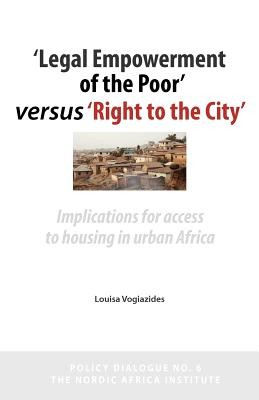
- We will send in 10–14 business days.
- Author: Louisa Vogiazides
- Publisher: Nordic Africa Institute
- Year: 2012
- Pages: 44
- ISBN-10: 9171067205
- ISBN-13: 9789171067203
- Format: 14 x 21.6 x 0.2 cm, minkšti viršeliai
- Language: English
- SAVE -10% with code: EXTRA
'legal Empowerment of the Poor' Versus 'right to the City' (e-book) (used book) | bookbook.eu
Reviews
Description
The challenge of urban deprivation and exclusion in the urban South has given rise to varied and shifting policies and ideas. Two sets of ideas have gained great currency in recent years in international policy and academic circles. The Legal Empowerment of the Poor approach, rooted in neoliberal thinking, focuses on the legal rights of the urban poor as the means to secure access to basic services and needs. The Right to the City perspective, on the other hand, stresses issues of citizenship and the appropriation and uses of urban space. This Policy Dialogue analyses the different ideological and normative foundations of the two perspectives and discusses how they lead to different policy formulations. It then takes a closer look at how the two perspectives find expression in contemporary discussions on and approaches to access to housing in urban Africa. To this end, it compares what each approach identifies as the source of the problem and recommends as the policy solution.
EXTRA 10 % discount with code: EXTRA
The promotion ends in 22d.03:09:05
The discount code is valid when purchasing from 10 €. Discounts do not stack.
- Author: Louisa Vogiazides
- Publisher: Nordic Africa Institute
- Year: 2012
- Pages: 44
- ISBN-10: 9171067205
- ISBN-13: 9789171067203
- Format: 14 x 21.6 x 0.2 cm, minkšti viršeliai
- Language: English English
The challenge of urban deprivation and exclusion in the urban South has given rise to varied and shifting policies and ideas. Two sets of ideas have gained great currency in recent years in international policy and academic circles. The Legal Empowerment of the Poor approach, rooted in neoliberal thinking, focuses on the legal rights of the urban poor as the means to secure access to basic services and needs. The Right to the City perspective, on the other hand, stresses issues of citizenship and the appropriation and uses of urban space. This Policy Dialogue analyses the different ideological and normative foundations of the two perspectives and discusses how they lead to different policy formulations. It then takes a closer look at how the two perspectives find expression in contemporary discussions on and approaches to access to housing in urban Africa. To this end, it compares what each approach identifies as the source of the problem and recommends as the policy solution.


Reviews